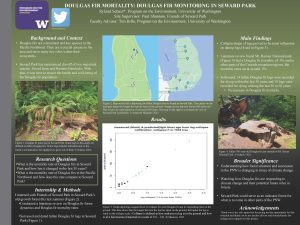Douglas Fir Mortality: Monitoring Douglas Firs in Seward Park
Douglas firs (DF) are a key and abundant tree species in the Pacific Northwest (PNW). DFs often dominate forests and serve various roles that include: becoming nurse logs, creating forest canopies, creating wildlife homes, and encouraging forest succession. Seward park is a DF dominated forest which has experienced decline in its major species (Western Hemlocks and Sword Ferns). This documented decline and elevated concerns raised the question: What is the mortality rate of DFs in Seward Park? With the effects of climate change increasing, longer summers and drought, the succession of PNW forests could be changing. The purpose of this study was to create an estimation on the mortality rate of DFs in Seward park to ensure that they were dying at their expected rate. To conduct this research, my site supervisor and I collected data on every fallen DF log we could locate within 20ft of the main trails. We surveyed for diameter at breast height, number of branches, level of collapse, number of epiphytes, and bark coverage. Upon gathering this data, we were able to use collapse as the most reliable measure of decay and created a model that approximated fall dates for DF logs. I also reviewed literature to identify a normal DF mortality rate. Through our research, we came to the conclusion that DFs in Seward park are within the normal range of DF mortality rates. These findings can prove to be helpful with forest adaption and succession concerns as climate change continues to progress.
